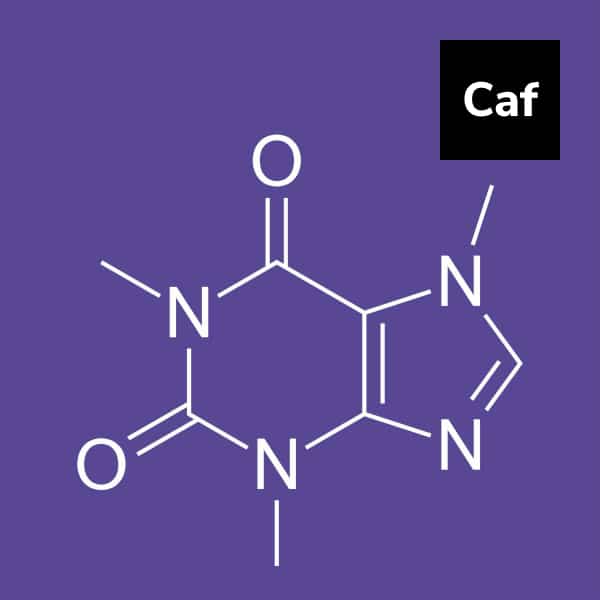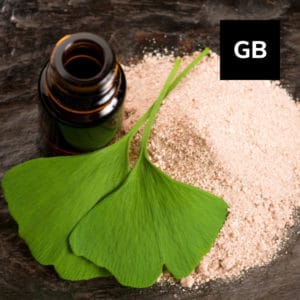Overview
Caffeine is derived from the cocoa bean and is found in coffee, tea, cola, guarana, and mate. In addition to its primary ingredient in numerous beverages, it has multiple pharmacological effects and is delivered in a variety of forms and products.
Key Benefits
- Increases alertness
- Improves focus
- Enhances memory
- Improves reaction time
- Improves endurance performance
- Provides antioxidant protection
- May help reduce asthma symptoms
- Helps support healthy weight
History of Usage
Caffeine has been extracted from the cocoa bean (the seeds of the cacao tree) and used for thousands of years as a medical, recreational, and ceremonial substance. Friedlieb Ferdinand Runge isolated it from cocoa beans into its purest form, a white crystalline material, in 1819.
It is now present in a wide variety of over-the-counter items, including energy supplements, athletic enhancement products, pain relief treatments, and cosmetic products.
Biochemistry
Caffeine is an alkaloid with a structure similar to that of theophylline and theobromine. It is derived from coffee, teas, and cacao beans. It boosts energy metabolism in the brain while decreasing cerebral blood flow, resulting in relative brain hypoperfusion.
Caffeine, as a stimulant, stimulates noradrenaline neurons and influences dopamine release in the brain. Many of caffeine’s alerting effects may be attributable to the activity of methylxanthine on serotonin neurons.
Because of its strong biological activity and ability to permeate the skin barrier, caffeine is increasingly being employed in cosmetics. Topical caffeine formulations available on the market usually include 3% caffeine. It is used in anti-cellulite products as an active ingredient because it lowers excess fat production in cells.
The inhibition of phosphodiesterase activity causes caffeine to accelerate fat degradation during lipolysis. It has excellent antioxidant properties and helps to protect cells from UV exposure. It also increases the blood microcirculation of the skin in cosmetics and stimulates hair growth by blocking 5-reductases.
Caffeinated chewing gum is absorbed more rapidly through the mucosa than the dispersal and absorption of the capsule into the stomach, but the absorption of total caffeine does not change over time.
Caffeine mouthwash, in addition to its absorption in the mouth, may stimulate nerves with direct connections to the brain. Caffeine mouth rinse, on the other hand, has not been found to have a substantial effect on cognitive performance.
Caffeine sprays and mouth of aerosol can excite nerves with direct brain connections and reach the blood stream via mucosal and pulmonary absorption, while there can be no evidence for the administration of caffeine. More research is needed to evaluate alternate caffeine administration methods, such as direct measurements of brain activation and its entry into the blood, as well as more studies with trained athletes.
Recent Trends
Caffeine has been used in beverages as a stimulant for the brain and physical function for centuries. Today it is offered in various forms, including capsules, sports drinks, chewing gum, bars, gels, mouth rinses, energy drinks, aerosols, and even as a transdermal patch that releases caffeine gradually into the skin.
The market for caffeine can be divided in food, beverages, drugs, flavors and fragrances and other products.
Food and beverages is the highest growing sector in the caffeine market and is expected to grow in the next several years. The use of drugs and flavorings is somewhat growing, and the segment is boosting by research and development.
The global market size for caffeinated drinks in 2018 was estimated at USD 202.63 billion. From 2019 to 2025, the market is anticipated to grow by a CAGR of 6.81%.
Precautions
A 400 gram caffeine consumption is safe for an adult as a stimulant, but it should be restricted in the case of teenagers.
Results were contradictory, although studies connected coffee and tea intake to higher risk of error, fetal death and low birth weight. In the American College of Obstetricians and Gynécologists there appears to be no erroneous or preterm birth of modest caffeine intake —200 mg a day or an equal to 2 8-ounce tbs of coffee.
Caffeine could lead to sleep disturbance, irritability and an increased bowel movement in infants who are breastfed in nursing women.
For those with epileptic disease or other seizure disorders should take it with caution.
Caffeine is a stimulant for the central nervous system, which may cause an overdose and seizures. Furthermore, overdose may cause gastrointestinal upset, nausea, vomiting, diarrhea.
The efficiency of certain therapeutic products may be impaired by caffeine. Check with your healthcare provider or pharmacist if you are taking a medicine.
References
- Gahr M. Koffein, das am häufigsten konsumierte Psychostimulans: eine narrative Übersichtsarbeit [Caffeine, the most frequently consumed psychostimulant: a narrative review article]. Fortschr Neurol Psychiatr. 2020 May;88(5):318-330. German. doi: 10.1055/a-0985-4236. Epub 2019 Oct 14. PMID: 31610604.
- Herman A, Herman AP. Caffeine’s mechanisms of action and its cosmetic use. Skin Pharmacol Physiol. 2013;26(1):8-14. doi: 10.1159/000343174. Epub 2012 Oct 11. PMID: 23075568.
- Wickham KA, Spriet LL. Administration of Caffeine in Alternate Forms. Sports Med. 2018 Mar;48(Suppl 1):79-91. doi: 10.1007/s40279-017-0848-2. PMID: 29368182; PMCID: PMC5790855.
- Cappelletti S, Piacentino D, Sani G, Aromatario M: Caffeine: cognitive and physical performance enhancer or psychoactive drug? Curr Neuropharmacol. 2015 Jan;13(1):71-88. doi: 10.2174/1570159X13666141210215655.
- Nehlig A, Daval JL, Debry G. Caffeine and the central nervous system: mechanisms of action, biochemical, metabolic and psychostimulant effects. Brain Res Brain Res Rev. 1992 May-Aug;17(2):139-70. doi: 10.1016/0165-0173(92)90012-b. PMID: 1356551.
- Icken D, Feller S, Engeli S, Mayr A, Müller A, Hilbert A, de Zwaan M. Caffeine intake is related to successful weight loss maintenance. Eur J Clin Nutr. 2016 Apr;70(4):532-4. doi: 10.1038/ejcn.2015.183. Epub 2015 Nov 11. PMID: 26554757.
- Tabrizi R, Saneei P, Lankarani KB, Akbari M, Kolahdooz F, Esmaillzadeh A, Nadi-Ravandi S, Mazoochi M, Asemi Z. The effects of caffeine intake on weight loss: a systematic review and dos-response meta-analysis of randomized controlled trials. Crit Rev Food Sci Nutr. 2019;59(16):2688-2696. doi: 10.1080/10408398.2018.1507996. Epub 2018 Oct 18. PMID: 30335479.




